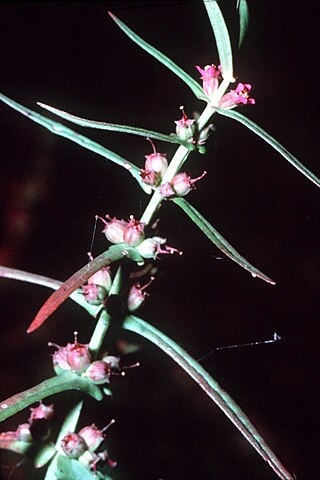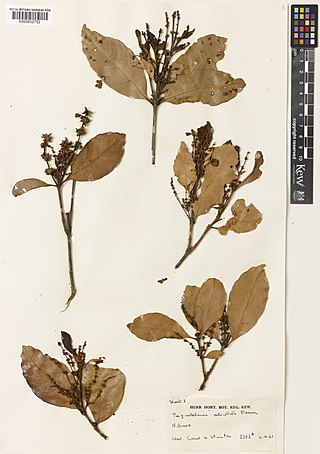
Sciadopitys verticillata, the kōyamaki or Japanese umbrella-pine, is a unique conifer endemic to Japan. It is the sole living member of the family Sciadopityaceae and genus Sciadopitys, a living fossil with no close relatives. The oldest fossils of Sciadopitys are from the Late Cretaceous of Japan, and the genus was widespread in Laurasia during most of the Cenozoic, especially in Europe until the Pliocene.

Hydrilla (waterthyme) is a genus of aquatic plant, usually treated as containing just one species, Hydrilla verticillata, though some botanists divide it into several species. It is native to the cool and warm waters of the Old World in Asia, Africa and Australia, with a sparse, scattered distribution; in Australia from Northern Territory, Queensland, and New South Wales.

Ilex verticillata, the winterberry, is a species of holly native to eastern North America in the United States and southeast Canada, from Newfoundland west to Ontario and Minnesota, and south to Alabama.
Gustavia verticillata is a species of woody plant in the family Lecythidaceae. It is found in Colombia and Panama.
Haplochromis argenteus is a critically endangered species of cichlid fish that is endemic to the Lake Victoria system in Africa. This species reaches a standard length of 20.2 cm (8.0 in). The species declined rapidly after the Nile perch was introduced to Lake Victoria. Last reported from this lake in 1983, it was considered possibly extinct when evaluated by the IUCN in 2010. However, that same year, several were recorded during a fish survey of Lake Bisina, a satellite lake of Lake Kyoga.
Pradosia verticillata is a species of plant in the family Sapotaceae. It is found in Brazil and French Guiana.
Romeroa is a genus of plant in the Bignoniaceae family. Its only species is Romeroa verticillata. It is endemic to Colombia.
Scaevola verticillata is a species of plant in the family Goodeniaceae. It is endemic to Borneo where it is confined to Sarawak.

Hydrocotyle verticillata, also known as whorled pennywort, whorled marshpennywort or shield pennywort, is a flowering plant found in South and North America and the West Indies. Its creeping habit and unusual leaves give it its common names. It grows in places that are marshy, boggy, or even wet.
Hydrocotyle verticillata is used in aquaria, where it is undemanding; it does prefer a good substrate, however, and at least moderate light. It benefits from additional carbon dioxide. It is widely used as a foreground plant.

Ammannia is a genus of around 100 species of plants often referred to as redstems from wet areas in America, Africa, Asia, Australia and Europe. Several species are grown as decorative plants in aquariums.

Ammannia robusta is a species of flowering plant in the loosestrife family known by the common name grand redstem. It is widespread across much of North America with additional populations in southeastern Brazil.

Allocasuarina verticillata, commonly known as drooping she-oak or drooping sheoak, is a nitrogen-fixing native tree of southeastern Australia.

Cissus verticillata, the princess vine or seasonvine, is an evergreen perennial vine in the grapevine family Vitaceae.
Nepean Bay Conservation Park is a protected area in the Australian state of South Australia on Kangaroo Island. It was dedicated in 1974 for the protection of flora and fauna, and is the only reserved area of coastal sandplain on the island.

Ammannia baccifera, also known as the monarch redstem or blistering ammannia is a species in the family Lythraceae. It is widespread in the tropical regions of Asia, America and Africa. It has been naturalized in Spain. It is annual and herbaceous, and can be found in marshes, swamps, rice fields and water courses at low elevations. It is considered endangered in Israel, but because it is widespread and common elsewhere, the IUCN considers it to be 'Least Concern'. The plant Ammannia baccifera Linn. is erect, branched, smooth, slender, annual, more or less purplish herb 10 to 50 centimeters in height. The stems are somewhat 4-angled. The leaves are oblong, oblanceolate, or narrowly elliptic, about 3.5 centimeters long – those on the branches very numerous, small, and 1 to 1.5 centimeters long – with narrowed base and pointed or somewhat rounded tip. The flowers are small, about 1.2 millimeters long, greenish or purplish, and borne in dense axillary clusters. The capsules are nearly spherical, depressed, about 1.2 millimeters in diameter, purple, and irregularly circumscribes above the middle. The seeds are black.

Ammannia multiflora, commonly known as many-flower ammannia and jerry-jerry in Victoria, is a species in the family Lythraceae. It is widespread in Asia, tropical and sub-tropical Africa and Australia. It can be found in shallow water and damp heavy soils.

Osteochilus vittatus is a species of cyprinid fish from Southeast Asia. Its common name is bonylip barb,Hasselt's bony-lipped barb, hard-lipped barb, or silver sharkminnow. It grows to 32 cm (13 in) SL.

Ammannia auriculata, commonly known as eared redstem, is a species in the family Lythraceae that is found in tropical and subtropicalt areas around much of the world.

Trigonobalanus verticillata is a species of plant in the family Fagaceae. It is a tree native to Borneo, Sumatra, Sulawesi, the Malay Peninsula, and Hainan.













